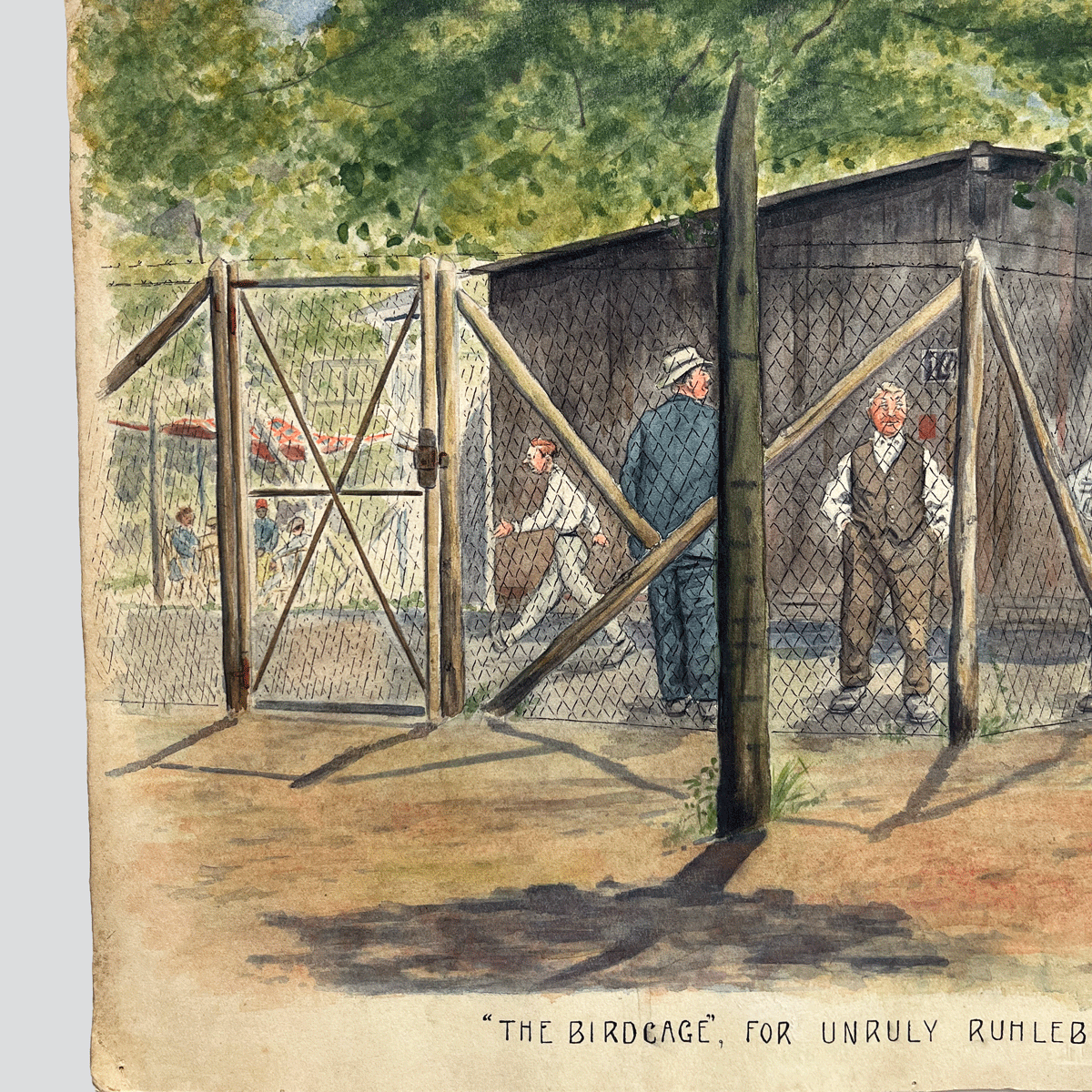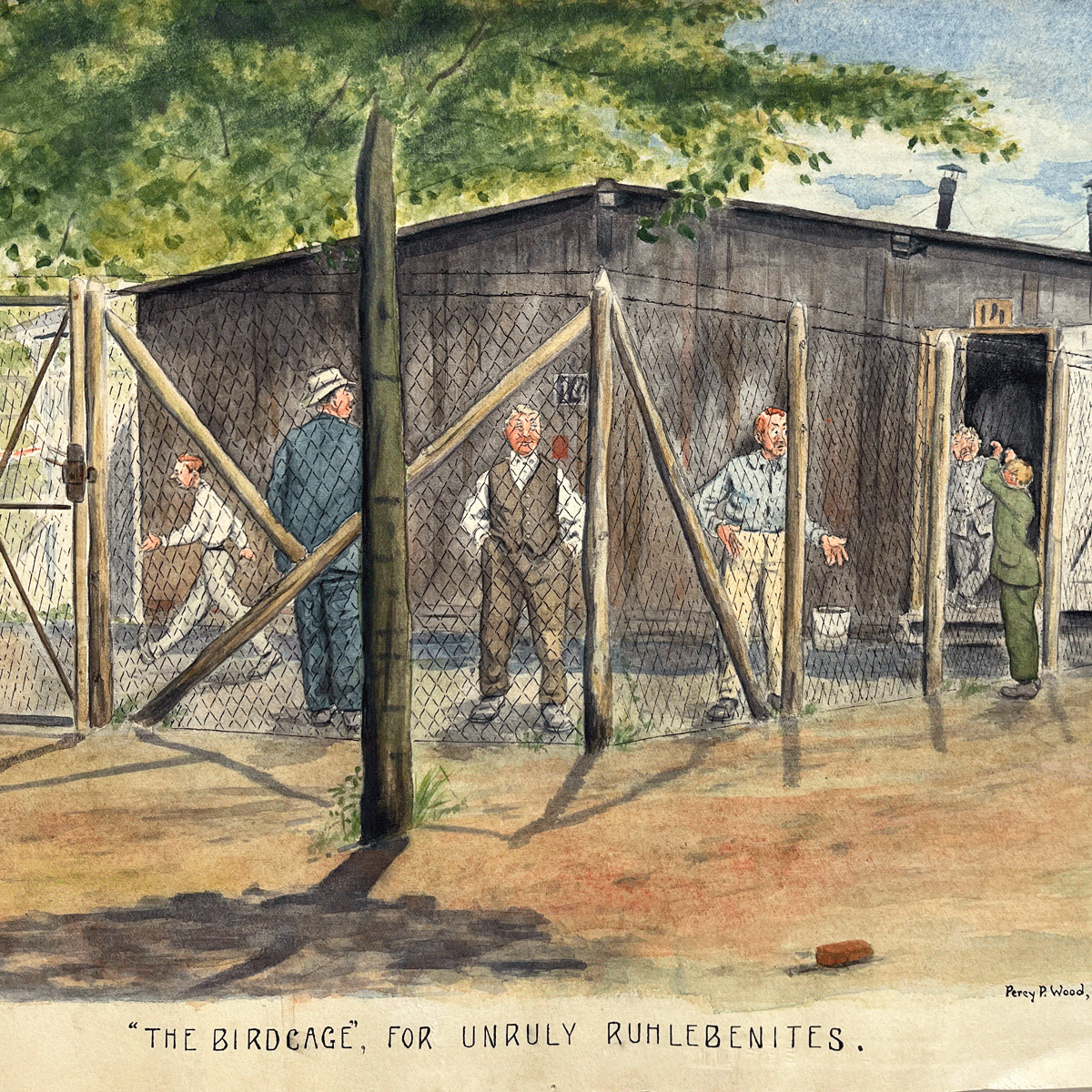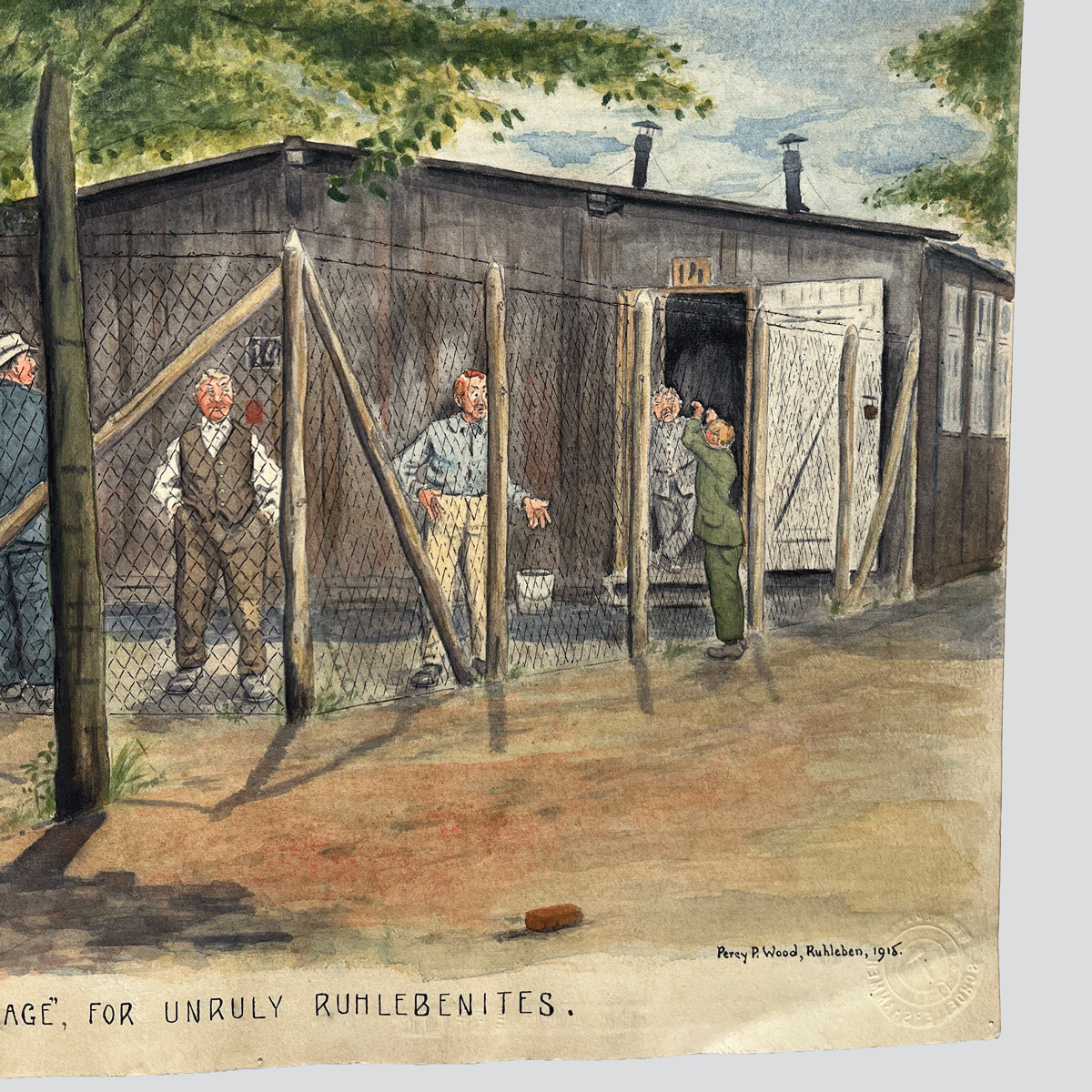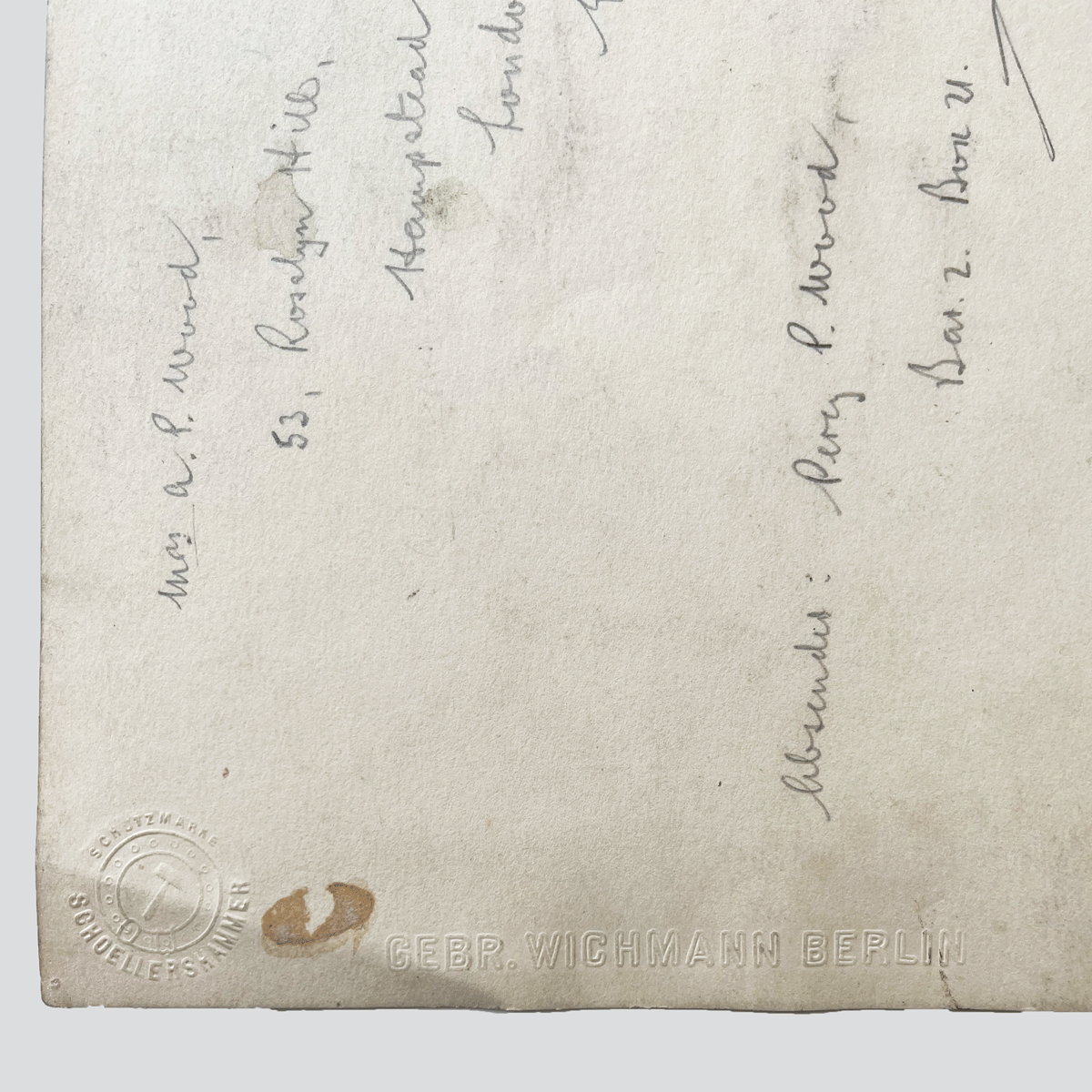 Image 1 of 8
Image 1 of 8

 Image 2 of 8
Image 2 of 8

 Image 3 of 8
Image 3 of 8

 Image 4 of 8
Image 4 of 8

 Image 5 of 8
Image 5 of 8

 Image 6 of 8
Image 6 of 8

 Image 7 of 8
Image 7 of 8

 Image 8 of 8
Image 8 of 8









(WOOD, Percy.) Original drawing created whilst being held as a civilian prisoner at the Ruhleben Internment Camp, Germany.
A wonderful original drawing created by Percy Wood whilst being held as a civilian prisoner at the Ruhleben Internment Camp, Germany. Illustrated in pen, wax crayon and watercolour, the drawing depicts prisoners of war standing outside a prison camp hut surrounded by barbed wire. The drawing is titled “The Birdcage, For Unruly Ruhlebenites”, additionally signed “Percy P. Wood”, dated “1918”, and located “Ruhleben”, by the artist Percy Wood. Unframed, 36cm*25.4cm, prison stamp to the bottom right corner of the drawing, two stamps together with postal details for a family member in London on the reverse.
The drawing has been well looked after and carefully preserved. Each corner of the drawing has a tiny pin hole, a very slight crease to the bottom right corner of the drawing; very good.
Percy Wood was born in Hull in 1877. According to citizen registries, Wood worked in Berlin as a language teacher. The onset of WWI saw all foreign “aliens” who were living, working, studying or holidaying in Germany at that time rounded up and interned. Wood was held at Ruhleben internment camp together with these other male citizens of the Allied Powers, most of whom were British. Alongside the works he sent home to family in England, Wood is recorded as an artist for several of the camp magazine publications. Wood, with his fellow camp artists Wade and Walker, held an exhibition of humorous drawings in the studio at Ruhleben in April 1917.
The Germans complied with the Geneva Convention in their treatment of the civilian prisoners. The internees were a diverse group of individuals who, over time, managed a “home rule” administration of the camp which included a police force, library and postal service. “Captains” were elected for each block and committees were formed. Further, a rich cultural community was created encompassing the pursuit of artistic, musical and sporting activities. The internees established an orchestra as well as constructing a five-hole golf course and sporting associations for cricket, rugby, hockey, boxing and tennis. The British civilian internees were treated well by the Germans. Britain and its Empire held approximately 36,000 German civilians in their own camps and any bad treatment of the Ruhleben internees could, potentially, have had negative consequences for their German counterparts being held by the British.
(Imperial War Museum.) (International Encyclopaedia of the First World War.) (Trinity College Dublin.) (Citizen Registries.)
Please contact us for shipping costs if ordering from outside the UK.
A wonderful original drawing created by Percy Wood whilst being held as a civilian prisoner at the Ruhleben Internment Camp, Germany. Illustrated in pen, wax crayon and watercolour, the drawing depicts prisoners of war standing outside a prison camp hut surrounded by barbed wire. The drawing is titled “The Birdcage, For Unruly Ruhlebenites”, additionally signed “Percy P. Wood”, dated “1918”, and located “Ruhleben”, by the artist Percy Wood. Unframed, 36cm*25.4cm, prison stamp to the bottom right corner of the drawing, two stamps together with postal details for a family member in London on the reverse.
The drawing has been well looked after and carefully preserved. Each corner of the drawing has a tiny pin hole, a very slight crease to the bottom right corner of the drawing; very good.
Percy Wood was born in Hull in 1877. According to citizen registries, Wood worked in Berlin as a language teacher. The onset of WWI saw all foreign “aliens” who were living, working, studying or holidaying in Germany at that time rounded up and interned. Wood was held at Ruhleben internment camp together with these other male citizens of the Allied Powers, most of whom were British. Alongside the works he sent home to family in England, Wood is recorded as an artist for several of the camp magazine publications. Wood, with his fellow camp artists Wade and Walker, held an exhibition of humorous drawings in the studio at Ruhleben in April 1917.
The Germans complied with the Geneva Convention in their treatment of the civilian prisoners. The internees were a diverse group of individuals who, over time, managed a “home rule” administration of the camp which included a police force, library and postal service. “Captains” were elected for each block and committees were formed. Further, a rich cultural community was created encompassing the pursuit of artistic, musical and sporting activities. The internees established an orchestra as well as constructing a five-hole golf course and sporting associations for cricket, rugby, hockey, boxing and tennis. The British civilian internees were treated well by the Germans. Britain and its Empire held approximately 36,000 German civilians in their own camps and any bad treatment of the Ruhleben internees could, potentially, have had negative consequences for their German counterparts being held by the British.
(Imperial War Museum.) (International Encyclopaedia of the First World War.) (Trinity College Dublin.) (Citizen Registries.)
Please contact us for shipping costs if ordering from outside the UK.
A wonderful original drawing created by Percy Wood whilst being held as a civilian prisoner at the Ruhleben Internment Camp, Germany. Illustrated in pen, wax crayon and watercolour, the drawing depicts prisoners of war standing outside a prison camp hut surrounded by barbed wire. The drawing is titled “The Birdcage, For Unruly Ruhlebenites”, additionally signed “Percy P. Wood”, dated “1918”, and located “Ruhleben”, by the artist Percy Wood. Unframed, 36cm*25.4cm, prison stamp to the bottom right corner of the drawing, two stamps together with postal details for a family member in London on the reverse.
The drawing has been well looked after and carefully preserved. Each corner of the drawing has a tiny pin hole, a very slight crease to the bottom right corner of the drawing; very good.
Percy Wood was born in Hull in 1877. According to citizen registries, Wood worked in Berlin as a language teacher. The onset of WWI saw all foreign “aliens” who were living, working, studying or holidaying in Germany at that time rounded up and interned. Wood was held at Ruhleben internment camp together with these other male citizens of the Allied Powers, most of whom were British. Alongside the works he sent home to family in England, Wood is recorded as an artist for several of the camp magazine publications. Wood, with his fellow camp artists Wade and Walker, held an exhibition of humorous drawings in the studio at Ruhleben in April 1917.
The Germans complied with the Geneva Convention in their treatment of the civilian prisoners. The internees were a diverse group of individuals who, over time, managed a “home rule” administration of the camp which included a police force, library and postal service. “Captains” were elected for each block and committees were formed. Further, a rich cultural community was created encompassing the pursuit of artistic, musical and sporting activities. The internees established an orchestra as well as constructing a five-hole golf course and sporting associations for cricket, rugby, hockey, boxing and tennis. The British civilian internees were treated well by the Germans. Britain and its Empire held approximately 36,000 German civilians in their own camps and any bad treatment of the Ruhleben internees could, potentially, have had negative consequences for their German counterparts being held by the British.
(Imperial War Museum.) (International Encyclopaedia of the First World War.) (Trinity College Dublin.) (Citizen Registries.)
Please contact us for shipping costs if ordering from outside the UK.
